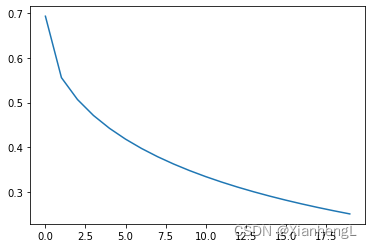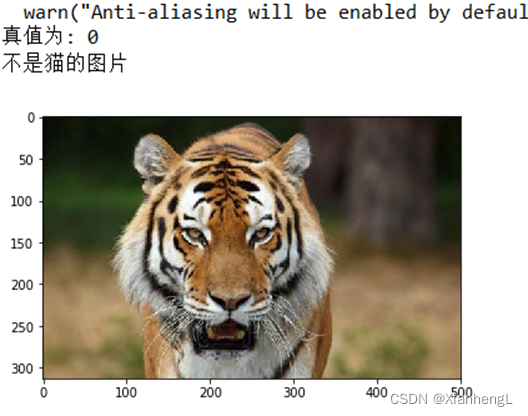单层神经网络
训练2000次
训练集准确率:96%
验证集准确率:74%
1.数据导入
数据集下载在我的资源里,免费下载联系邮箱26676478374@qq.com。
import numpy as np
import h5py
def load_dataset():
train_dataset = h5py.File('datasets/train_catvnoncat.h5', "r")
train_set_x_orig = np.array(train_dataset["train_set_x"][:]) # your train set features
train_set_y_orig = np.array(train_dataset["train_set_y"][:]) # your train set labels
test_dataset = h5py.File('datasets/test_catvnoncat.h5', "r")
test_set_x_orig = np.array(test_dataset["test_set_x"][:]) # your test set features
test_set_y_orig = np.array(test_dataset["test_set_y"][:]) # your test set labels
classes = np.array(test_dataset["list_classes"][:]) # the list of classes
train_set_y_orig = train_set_y_orig.reshape((1, train_set_y_orig.shape[0]))
test_set_y_orig = test_set_y_orig.reshape((1, test_set_y_orig.shape[0]))
return train_set_x_orig, train_set_y_orig, test_set_x_orig, test_set_y_orig, classes
2.数据预处理
(1)降维:一幅 64×64的图像的在数据集中是以 64×64×3的矩阵形状进行存储的,为了满足神经网络的输入格式,在 Python 中可以使用 reshape 函数改变矩阵的形状,对图像进行降维处理。
(2)归一化处理:imshow()显示图像时对double型是认为在0到1范围内,因此将颜色值全部除255。
#降维
#对于一个形状为 (a,b,c,d)的矩阵,通过 M1.reshape(M1.shape[0],−1).T 就可以将其转换为形状为 (b×c×d,a)的矩阵
train_set_x_flatten = train_set_x_orig.reshape(train_set_x_orig.shape[0],-1).T
test_set_x_flatten = test_set_x_orig.reshape(test_set_x_orig.shape[0],-1).T
#归一处
train_set_x = 1.0*train_set_x_flatten/255
test_set_x = 1.0*test_set_x_flatten/255
3.构建神经网络
def sigmoid(z):
s = 1 / (1 + np.exp(-z))
return s
def initialize(n):
w = np.zeros(shape=(n,1),dtype = np.float32)
b = 0
return w,b
def spread(w,b,X,Y):
#向前传播
m = X.shape[1]
A = sigmoid(np.dot(w.T,X)+b)
J = -1/m * np.sum((Y * np.log(A) + (1-Y) * np.log(1-A)),axis = 1) #成本函数
#向后传播
dw = 1/m * np.dot(X,(A-Y).T)
db = 1/m * np.sum(A-Y,axis = 1)
J = np.squeeze(J) #将cost从矩阵转化为一个实数,从数组中把shape中为1的维度去掉
return dw,db,J
def gradient_descent(w,b,X,Y,train_times,learning_rate):
costs = []
for i in range(train_times):
dw,db,J = spread(w,b,X,Y)
w = w -learning_rate * dw
b = b -learning_rate * db
#记录成本函数
if i%100 ==0:
print('第',i+100,'次的成本函数:',J)
costs.append(J)
return w,b,costs
def predict(w,b,X):
m = X.shape[1]
Y_prediction = np.zeros((1,m))
#确保矩阵维数匹配
w = w.reshape(X.shape[0],1)
#计算Logistic回归
A = sigmoid(np.dot(w.T,X) + b)
for i in range(A.shape[1]):
if A[0,i] > 0.5:
Y_prediction[0,i] = 1
else:
Y_prediction[0,i] = 0
#确保矩阵维数正确
assert(Y_prediction.shape == (1,m))
return Y_prediction
4.训练预测
def MyTestModel(X_train,Y_train,X_test,Y_test,train_times = 100,learning_rate = 0.005):
#初始化参数
w,b =initialize(X_train.shape[0])
#梯度下降训练
w,b,costs = gradient_descent(w,b,X_train,Y_train,train_times,learning_rate)
#训练后测试结果
Y_prediction_train = predict(w,b,X_train)
Y_prediction_test = predict(w,b,X_test)
#输出效果
print('训练集准确率:', '%.2f' % (100 - np.mean(np.abs(Y_prediction_train - Y_train))*100),'%')
print('测试集准确率:', '%.2f' % (100 - np.mean(np.abs(Y_prediction_test - Y_test))*100),'%') #np.mean 求取平均值
print(Y_prediction_test)
return w,b,costs,Y_prediction_test
#效果测试
w,b,costs,Y_prediction_test = MyTestModel(train_set_x,train_set_y,test_set_x,test_set_y,2000,0.002)
plot_costs = np.squeeze(costs)
plt.plot(plot_costs)
代价函数曲线:

5.图像测试
#测试图片
def isCat(my_image = "my_image.jpg", dirname = "images/"):
# 初始化图片路径
fname = dirname + my_image
# 读取图片
image = np.array(plt.imread(fname))
# 将图片转换为训练集一样的尺寸
num_px = train_set_x_orig.shape[2]
my_image = skimage.transform.resize(image, output_shape=(num_px,num_px)).reshape((1, num_px*num_px*3)).T
# 预测
my_predicted_image = predict(w, b, my_image)
# 绘图与结果输出
plt.imshow(image)
if float(my_predicted_image) == 1.0:
print('这是一张猫的图片')
else:
print('不是猫的图片')
isCat(my_image = "xxx.jpg", dirname="images/")

完整代码:
import numpy as np
import matplotlib.pyplot as plt
import scipy #数值运算、图像处理
import h5py #存放数据集和组
import skimage
from scipy import ndimage #N维图像包
from PIL import Image
from lr_utils import load_dataset
train_set_x_orig, train_set_y, test_set_x_orig, test_set_y, classes = load_dataset()
#降维
train_set_x_flatten = train_set_x_orig.reshape(train_set_x_orig.shape[0],-1).T
test_set_x_flatten = test_set_x_orig.reshape(test_set_x_orig.shape[0],-1).T
#归一化
train_set_x = 1.0*train_set_x_flatten/255
test_set_x = 1.0*test_set_x_flatten/255
'''********搭建神经网络**********'''
def sigmoid(z):
s = 1 / (1 + np.exp(-z))
return s
def initialize(n):
w = np.zeros(shape=(n,1),dtype = np.float32)
b = 0
return w,b
def spread(w,b,X,Y):
#向前传播
m = X.shape[1]
A = sigmoid(np.dot(w.T,X)+b)
J = -1/m * np.sum((Y * np.log(A) + (1-Y) * np.log(1-A)),axis = 1) #成本函数
#向后传播
dw = 1/m * np.dot(X,(A-Y).T)
db = 1/m * np.sum(A-Y,axis = 1)
J = np.squeeze(J) #将cost从矩阵转化为一个实数,从数组中把shape中为1的维度去掉
return dw,db,J
def gradient_descent(w,b,X,Y,train_times,learning_rate):
costs = []
for i in range(train_times):
dw,db,J = spread(w,b,X,Y)
w = w -learning_rate * dw
b = b -learning_rate * db
#记录成本函数
if i%100 ==0:
print('第',i+100,'次的成本函数:',J)
costs.append(J)
return w,b,costs
def predict(w,b,X):
m = X.shape[1]
Y_prediction = np.zeros((1,m))
#确保矩阵维数匹配
w = w.reshape(X.shape[0],1)
#计算Logistic回归
A = sigmoid(np.dot(w.T,X) + b)
for i in range(A.shape[1]):
if A[0,i] > 0.5:
Y_prediction[0,i] = 1
else:
Y_prediction[0,i] = 0
#确保矩阵维数正确
assert(Y_prediction.shape == (1,m))
return Y_prediction
def MyTestModel(X_train,Y_train,X_test,Y_test,train_times = 100,learning_rate = 0.005):
#初始化参数
w,b =initialize(X_train.shape[0])
#梯度下降训练
w,b,costs = gradient_descent(w,b,X_train,Y_train,train_times,learning_rate)
#训练后测试结果
Y_prediction_train = predict(w,b,X_train)
Y_prediction_test = predict(w,b,X_test)
#输出效果
print('训练集准确率:', '%.2f' % (100 - np.mean(np.abs(Y_prediction_train - Y_train))*100),'%')
print('测试集准确率:', '%.2f' % (100 - np.mean(np.abs(Y_prediction_test - Y_test))*100),'%') #np.mean 求取平均值
print(Y_prediction_test)
return w,b,costs,Y_prediction_test
#效果测试
w,b,costs,Y_prediction_test = MyTestModel(train_set_x,train_set_y,test_set_x,test_set_y,2000,0.002)
plot_costs = np.squeeze(costs)
plt.plot(plot_costs)
#测试图片
def isCat(my_image = "my_image.jpg", dirname = "images/"):
# 初始化图片路径
fname = dirname + my_image
# 读取图片
image = np.array(plt.imread(fname))
# 将图片转换为训练集一样的尺寸
num_px = train_set_x_orig.shape[2]
my_image = skimage.transform.resize(image, output_shape=(num_px,num_px)).reshape((1, num_px*num_px*3)).T
# 预测
my_predicted_image = predict(w, b, my_image)
# 绘图与结果输出
plt.imshow(image)
if float(my_predicted_image) == 1.0:
print('这是一张猫的图片')
else:
print('不是猫的图片')






















 694
694











 被折叠的 条评论
为什么被折叠?
被折叠的 条评论
为什么被折叠?










